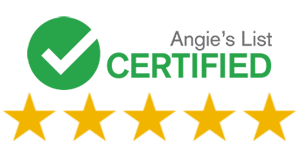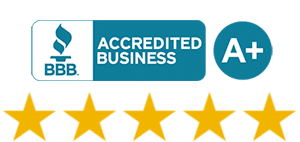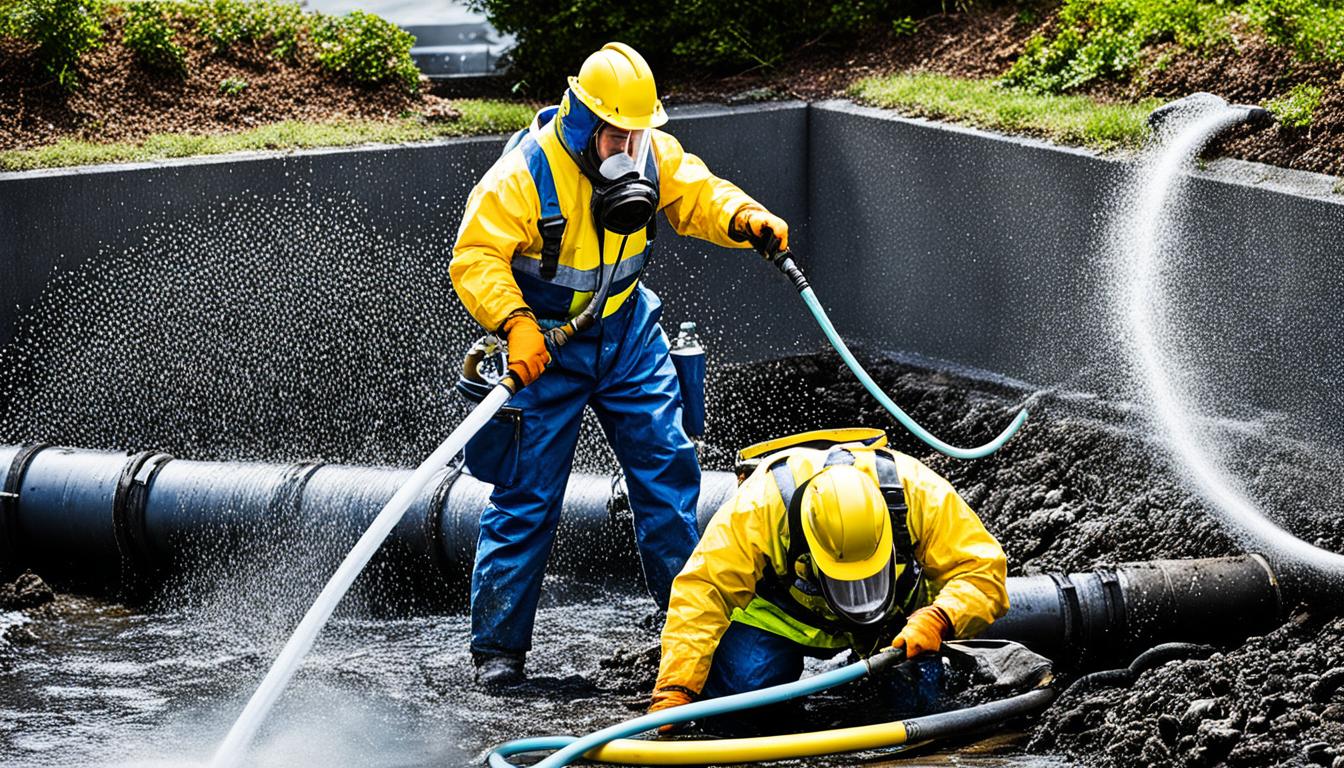When sewage shows up, it raises an important question: for how long does it stay unsafe? The time it takes for rooms to become safe after sewage contamination is crucial. It affects our health and the environment heavily. This problem lingers for a long time, especially in damp places like basements and crawl spaces. These areas are perfect for germs to grow and make us sick.
Getting rid of sewage’s effects takes time. How big the problem is and where it happened matters a lot. The time it takes to clear up varies. Time and the place work together to speed up or slow down the cleanup. Even when we can’t see it, a stale smell tells us germs are still around. This smell warns us that harmful bacteria are still active.
The issue is more than just about a bad smell. It’s about keeping us safe and healthy in our homes. Putting off fixing the problem strengthens the germs’ hold. It’s really important to know how long this problem will last to make our homes safe again.
Key Takeaways
- How long sewage stays harmful depends on how bad the damage is and the conditions it’s in.
- Places with a lot of moisture keep germs alive and make them more of a danger after a sewage problem.
- Cleaning up right away and making sure everything dries well are key. This helps get rid of bad smells and cuts the health risks.
- Germ growth can go on unnoticed. This is why acting fast on sewer backups is so important.
- It might take an expert to figure out how bad the damage is and what needs to be done to fix it.
Understanding Sewage Contamination and its Risks
The risks from sewage overflow are serious and complex. They can harm both property and health. When sewage is not treated, it’s filled with harmful organisms. These include bacteria, viruses, and parasites.
These harmful things can make people sick. This sickness can be less severe, like skin problems or coughs. Or, it can lead to stomach issues like not feeling well and stomach pain.
- Property damage is a big worry too. If sewage gets into a home, the damage to it can be very bad and expensive to fix.
- Things like walls, floors, and furniture can soak up the sewage. This causes bad smells and might make the house weak.
It’s important to prevent sewage from overflowing. Doing so helps keep living spaces safe and protects property from harm.
Initial Response and Cleanup Procedures
The first steps after finding sewage are crucial for health and safety. A good cleanup protocol lowers the risk of diseases and damages. It’s vital to start cleaning up right away.
Wearing the right gear is key. This means waterproof boots, gloves, and eye protection. This gear stops germs from getting on you.
- Assessment of Contaminated Areas: Immediate inspection to determine the extent of the contamination.
- Removal of Contaminants: Utilizing pumps and wet vacuums to eliminate standing wastewater efficiently.
- Application of Disinfectants: Employing recommended disinfection methods to cleanse surfaces thoroughly.
After these early steps, you need to focus on items that got wet or dirty:
- Throwing out things like mattresses that can’t be cleaned.
- Using air movers to dry wet areas quickly.
- Spreading garden lime on soil to get rid of smells and break down waste.
Disinfecting everything well is crucial. It’s not just about making things look clean. It’s about making them safe, too. Always follow the directions on cleaning product labels.
Finally, opening windows helps clean the air. It gets rid of any leftover bad smells or germs. This step makes sure the cleanup job is complete.
The Lingering Effects of Contamination on Various Materials
The impact of material damage from sewage extends even after the cleanup. It affects many surfaces and materials in homes. If not fixed properly, these issues can keep causing problems. Knowing how much and what type of damage has happened is key to cleaning it up.
Things like carpets and insulation soak up sewage easily. This makes them a perfect place for harmful germs to hang around. These germs can lower air quality and make people sick for a long time.
- Carpeting may require deep cleaning or replacement to eliminate contaminants.
- Insulation affected by sewage must often be removed and replaced to prevent the spread of microorganisms.
Items made of harder stuff, like concrete, get sewage on their outside. They do not absorb as much, so they are a bit easier to clean. But, they still need a good wash and dry to keep from getting worse over time.
- Cleaning with high-grade disinfectants.
- Complete drying to ensure no moisture remains.
When sewage is really bad, parts of the building like wallboard and insulation may need to be taken out. Germs can hide inside them and make the building weaker. Plus, they can make the air inside not safe to breathe.
Things like appliances, furniture, and toys for kids usually need serious cleaning too. But, sometimes it is best to throw them away. Making sure the place is really clean is why experts in property decontamination are so important.
By cleaning well and sometimes getting rid of things, we can lower the risk from material damage from sewage. This helps make the place better and safer for people to live and work in.
Prevention Measures to Avoid Future Contamination
To avoid the dangers of sewage spills, a wide-ranging plan is crucial. This plan includes sewage spill prevention, plumbing maintenance, proper disposal practices, and infrastructure enhancements. By using these methods, people and communities can lower the risk of sewage leaks and overflows.
- Regular Plumbing Maintenance: Regular checks and upkeep of plumbing systems can stop problems before they start. This can help avoid expensive fixes and protect the environment.
- Use of Water-Saving Fixtures: Switching to low-flow toilets and showerheads cuts down on water usage. This lessens the chance of sewage systems getting overloaded.
- Proper Disposal Methods: It’s important to teach everyone what not to flush. Items like wipes, oils, and non-biodegradable materials should never go down the toilet. They can cause clogs that lead to spills.
- Keep faucets off unless you need them to reduce stress on plumbing systems.
- Fix leaks and clogs right away, no matter how small, to stop them from getting worse.
For the larger community and its infrastructure, these actions are essential:
- Improve sewage treatment facilities to manage more waste.
- Maintain and update sewer lines, especially in places with older systems.
Using these steps, communities can protect their surroundings and health. This way, they can lower the risk of sewage issues.
Professional Decontamination Services and Their Role
Professional sewage decontamination and biohazard cleaning services are crucial for managing dangerous sewage disasters. They ensure the environment is safe by removing harmful substances. This process brings peace of mind and safety back to the area.
Contamination causes fast bacteria growth, leading to health risks. Biohazard cleaning services utilise strong chemicals and modern tech to kill these organisms. This protects everyone in the building from illnesses.
- Emergency Response: When sewage disasters strike, quick emergency response is essential. Expert teams swiftly step in to stop the contamination’s spread, preventing further damage.
- Bacteria Eradication: These services aim not just to clean but to get rid of harmful pathogens. They ensure a deep cleansing, making every part of the affected area safe again.
Hiring professionals for sewage decontamination means you get a fast cleanup and avoid long-term health issues. Specialists follow strict safety guidelines, making the place clean and livable. This step is critical for the well-being of everyone involved.
Call All Klean today for professional sewage cleanup services at (509) 593-3548 for our Idaho area or at (509) 385-0882 for our Washington area.
Conclusion
Dealing with sewage contamination is serious but manageable. Quick and clear steps are key. Acting fast and cleaning up well reduces risks to health and damage to property. This quick response is vital for a safe and sound place to live.
Sometimes, the mess is too big for solo cleaning. Professional decontamination services offer essential help. They remove all harmful stuff, like bacteria and toxins. This ensures your home is safe to come back to. Their expertise makes all the difference.
It’s important to be ready and know what to do when faced with sewage problems. Everyone, from homeowners to the local government, has a role. By learning, preparing, and having expert teams ready, we protect against sewage disasters. This approach aims to stop trouble before it starts.









